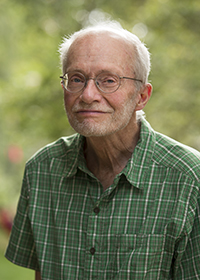Research Interests
My research is mainly in the field of theoretical statistical physics. One of my major interests is the properties of materials near the critical points of phase transitions, particularly surface and interfacial behavior. I have worked with renormalization-group and conformal-invariance methods, powerful theoretical tools that play an important role in critical phenomena and in field theory. Some of my current research is concerned with the long-range Casimir force between particles immersed in a fluid at is its critical point, due to the critical fluctuations of the fluid.
A second area on which I have concentrated is the conformational statistics of long, fluctuating polymer chains. For flexible polymers, some of the same theoretical techniques as in critical phenomena are applicable. In recent years co-workers and I have studied the statistical properties of semi-flexible polymers, such as DNA, in channels so narrow that the fluctuating polymer is stretched out inside the channel, with few overhangs or hairpin configurations. The nearly straight form of DNA is convenient for genomic mapping and assembly, and for such applications, confinement in nano-channels is a promising tool.
The equilibrium statistics of a semi-flexible polymer confined in a narrow channel is closely related to the statistics of a particle moving on the x axis with an acceleration which is random and has the form of Gaussian white noise. The latter topic, the random acceleration process, is of interest in its own right and in a variety of physical applications. My research is mainly concerned with the dynamics of a randomly-accelerated particle in the presence of boundaries.
Key Publications
T. W. Burkhardt and H.J.F. Knops, Renormalization-Group Results for the Blume-Capel Model in Two and Three Dimensions, Phys. Rev. B 15, 1602 (1977).
T. W. Burkhardt and E. Eisenriegler, Renormalization-Group Approach to the Ising Model with a Free Surface, Phys. Rev. B 17, 3213 (1977).
T. W. Burkhardt, Localisation-Delocalisation Transition in a Solid-on-Solid Model with a Pinning Potential, J. Phys. A 14, L63 (1981).
T. W. Burkhardt, Progress and Problems in Real-Space Renormalization (Chapter 1) and Bond-Moving and Variational Methods (Chapter 2) in Real-Space Renormalization, edited by T.W. Burkhardt and J.M.J. van Leeuwen (Springer, 1982).
T. W. Burkhardt, I. Guim, H. J. Hilhorst, and J. M. J. van Leeuwen, Boundary Magnetization and Spin Correlations in Inhomogeneous Two-Dimensional Ising Systems, Phys. Rev. B 30, 1486 (1984).
T. W. Burkhardt and E. Eisenriegler, Universal Order-Parameter Profiles in Confined Critical Systems with Boundary Fields, J. Phys. A 18, L83 (1985).
T. W. Burkhardt and B. Derrida, Moments of the Total Magnetization and Conformal Invariance in the Finite Two-Dimensional Ising Model, Phys. Rev. B 32, 7273 (1985).
T. W. Burkhardt and J.L. Cardy, Surface Critical Behaviour and Local Operators with Boundary-Induced Critical Profiles, J. Phys. A 20, L233 (1987).
I. Guim and T. W. Burkhardt, Transfer-Matrix Study of the Adsorption of a Flexible Self-Avoiding Polymer Chain in Two Dimensions, J. Phys. A 22,1131 (1989).
T. W. Burkhardt, E. Eisenriegler, and I. Guim, Conformal Theory of Energy Correlations in the Semi-Infinite Two-Dimensional O(N) Model, Nucl. Phys. B 316, 559 (1989).
T. W. Burkhardt, Propagator for the Wetting Transition in 1+1 Dimensions, Phys. Rev. B 40, 6987 (1989).
I. Guim, T. W. Burkhardt, and T. Xue, Surface Behaviour of the Fully Frustrated Two-Dimensional Ising Model, Phys. Rev. B 42, 10298 (1990).
T. W.Burkhardt and T. Xue, Density Profiles in Confined Critical Systems and Conformal Invariance, Phys. Rev. Lett. 66, 895 (1991).
T. W.Burkhardt and T. Xue, Conformal Invariance and Systems with Mixed Boundary Conditions, Nucl. Phys. B 354, 653 (1991).
T. W. Burkhardt and I. Guim, Conformal Theory of the Two-Dimensional Ising Model with Homogeneous Boundary Conditions and with Disordered Boundary Fields, Phys. Rev. B 47, 14306 (1993).
T. W. Burkhardt, Semiflexible Polymer in the Half Plane and Statistics of the Integral of a Brownian Curve, J. Phys. A 26, L115 (1993).
T. W. Burkhardt and E. Eisenriegler, Conformal Theory of the Two-Dimensional O(N) Model with Ordinary, Extraordinary, and Special Boundary Conditions, Nucl. Phys. B 424, 487 (1994).
T. W. Burkhardt and H. W. Diehl, Ordinary, Extraordinary, and Normal Surface Transitions: Extraordinary-Normal Equivalence and Simple Explanation of |T-Tc|2-? Singularities, Phys. Rev. B 50, 3894 (1994).
T. W. Burkhardt and E. Eisenriegler, Casimir Interaction of Spheres in a Fluid at the Critical Point, Phys. Rev. Lett. 74, 3189 (1995).
T. W. Burkhardt, Free Energy of a Semiflexible Polymer Confined Along an Axis, J. Phys. A 28, L629 (1995).
A. Drewitz, R. Leidl, T. W. Burkhardt, and H. W. Diehl, Surface Critical Behavior of Binary Alloys and Antiferromagnets: Dependence of the Universality Class on Surface Orientation, Phys. Rev. Lett. 78, 1090 (1997).
T. W. Burkhardt, Free Energy of a Semiflexible Polymer in a Tube and Statistics of a Randomly Accelerated Particle, J. Phys. A 30, L167 (1997).
T. W. Burkhardt, Dynamics of Absorption of a Randomly Accelerated Particle, J. Physics A 33 L429 (2000).
T. W. Burkhardt and S. N. Kotsev, Equilibrium of a Confined, Randomly Accelerated, Inelastic Particle: Is There Inelastic Collapse?, Phys. Rev. E 70, 026105 (2004).
T. W. Burkhardt, The Random Acceleration Process in Bounded Geometries, J. Stat. Mech., P07004 (2007).
Y. Yang, T. W. Burkhardt, and G. Gompper, Free Energy and Extension of a Semiflexible Polymer in Cylindrical Confining Geometries, Phys. Rev. E 76, 011804 (2007).
T. W. Burkhardt, G. Györgyi, N. R. Moloney, and Z. Rácz, Extreme Statistics of Time Series: Distribution of the Maximum Relative to the Initial Value, Phys. Rev. E 76, 041119 (2007).
T. W. Burkhardt, Y. Yang, and G. Gompper, Fluctuations of a Long, Semiflexible Polymer in a Narrow Channel, Phys. Rev. E 82, 041801 (2010).
T. W. Burkhardt, First Passage of a Randomly Accelerated Particle, Chapter 2 in First-Passage Phenomena and Their Applications, edited by R. Metzler, G. Oshanin, and S. Redner (World Scientific, 2014).

